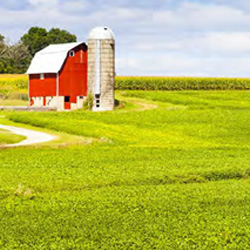Food and Agriculture

Importance of Indiana Agriculture
More than 60% of Indiana’s land is devoted to agriculture production via 56,800 farms and 14.7 million acres. Today, most farms are not engaged in subsistence farming, meaning that fewer individuals interact with daily efforts associated with raising or growing agricultural products. Therefore, the appreciation of agriculture’s place within the larger Hoosier economy — urban and rural — has diminished. This section provides a big-picture view of Indiana’s flourishing agriculture industry and recommends ways in which local government can incorporate goals and policies concerning agriculture in its comprehensive plans. For the latest up-to-date data and ag census update, please visit: https://www.nass.usda.gov/Publications/AgCensus/2017
Urban Agriculture
In Indiana and across the country, there is increased interest in, and attention to, urban agriculture. It is defined as growing and raising crops and livestock within the boundaries of a city. These crops and livestock are often intended for consumption by the local community — sometimes by the person producing the food, but many times at a scale where the food is shared or sold as well. Such potential issues as aesthetics, noises, smells and health might become central challenges to community conversations about urban agriculture. Many of these challenges can be directly addressed through the creation of supportive municipal policies and raised awareness of local resources, such as soil testing assistance. This section includes research, along with planning and zoning suggestions to help you navigate this area.
Livestock Production and Planning: Confined Feeding Operations
Livestock production has changed over the last few decades but still plays a large role in Indiana from standpoints of economic benefit and cultural tradition. This section addresses confined feeding operations (CFOs) specifically in terms of their benefits and the challenges sometimes associated with integrating livestock production into community planning. Finally, it describes several available tools and resources for planners and communities wishing to address CFOs.
Aquaculture
Indiana’s agricultural economy includes aquaculture (fish farming) and aquaponics (integrated fish and hydroponics farming). These enterprises produce fish for human consumption, recreational fishing and ornamental display. There are diverse species of fish produced in Indiana, and the interest in aquaculture and aquaponics results from the availability of such resources as vacant farm buildings and large, open ponds and water bodies. On the demand side, there is strong consumer preference for sustainably produced foods, local foods and fresh foods, which can lead to improvements in quality of environment and healthy local communities. This section helps planners and communities initiate conversations concerning aquaculture.
Local Food Systems
Communities interested in supporting local food infrastructure can include this support in their comprehensive and other local government planning efforts. Efforts to do this have been termed “local food system development.” This term refers to food that is produced in an area, whether it is a town, city or region. Acknowledging that all types of agriculture have value, a community can encourage additional development of local food-focused efforts through their policies, ordinances, zoning and related planning and regulatory tools. This section provides an overview and background of food systems, local planning considerations, policy and ordinance examples, and additional resources.
Indiana Site Certified Program
This section outlines the Indiana Office of Community and Rural Affairs’ (OCRA) Indiana Site Certified program — which designates sites that are well positioned for economic development. Indiana recognizes three tiers of readiness: Silver, Gold and Prime. Certified sites are featured on Indiana’s Site Selector Database and included in marketing materials for the Indiana Economic Development Corporation (IEDC). Communities of any size are eligible to apply for this certification, and applications are accepted on a rolling basis.
Site Considerations for the Rural Economic Development Model
This section highlights features of the Rural Economic Development Model developed by the Indiana Economic Development Association’s Rural Economic Development Affinity Group. Agriculture and ag-based business might require a different infrastructure footprint than other industry. Depending on a community or region’s agribusiness target, requirements for water, waste-water capacity, road surface and capacity, rail service, and bridge width and structure might all be unique. It’s critical to connect infrastructure requirements to ag-based economic development targets upfront. Relying on available resources can be a significant advantage. The planning and identification of specific industry needs should come together in each community, resulting in development of sites that meet unique needs for ag industry targets.
Land Use Tools for Preserving Farmland
Across Indiana, open space contributes to the look and feel of communities while providing amenities and resources. Open space is simply undeveloped land, and it can include such amenities as parks and golf courses, fields and pastures utilized for production agriculture, or natural areas such as woodlands and wetlands. Planning with open space in mind helps communities preserve these resources. This section focuses on farmland preservation and provides additional open-space planning resources.



